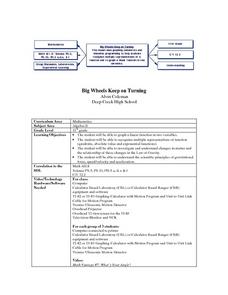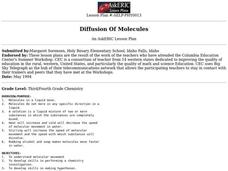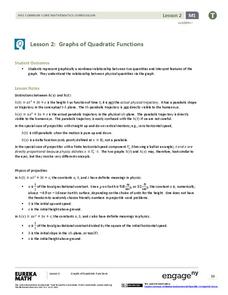Curated OER
Map Field of Current
Young scholars determine that moving charges create a magnetic field. They discover that the speed and direction of motion, the amount of charge, and the deflection angle observed are closely linked. A voltmeter, pendulum, and a...
Curated OER
"Fast and Slow"
High schoolers find a partner, they think about their favorite TV sport that they might like to perform in an unusual dance. They practice their chosen sport and students see if they can make a litter repeating pattern of three or four...
Curated OER
Wright Flight
Students explain and explain the interactive relationships between forces of lift and gravity, thrust and drag, as they apply to airplanes in motion. They know that Orville and Wilbur Wright flew the first airplane based on these...
Curated OER
Force Counterforce
Students hypothesize what forces affect the motion of a falling body. In this physical science lesson, students create diagrams and illustrations to support their hypothesis. They perform the experiment and record observations.
Curated OER
Persistence Forecasting
Students study weather forecasting. In this weather lesson, students explore forecasting weather methods and do a forecast. Students study weather reports and discuss the elements of a forecast. Students study the method of persistence...
Curated OER
F = Ma, Inertia, And Action-reaction
Fourth graders investigate Newton's Second and Third Laws of Motion. They determine what makes objects harder or easier to push. While investigating they determine how applying force in order balance out gravity allows things to stay...
Curated OER
Newton and his Laws
Students explore Newton's laws, including what they state, and what the intuitive meaning is of the first and third laws.
Curated OER
Simple Machines make work easier.
Students examine how simple machine work can make work easier. In this machines lesson students complete an activity that shows them what makes up a machine, and how to measure displacement and velocity.
Curated OER
Intro to 1D Kinematics with Physlets
Twelfth graders examine illustrations and animations on a Physlets CD in which they must describe motion, analyze graphs, and calculate initial velocity. The Physlet assists in providing active class participation in discussion.
Curated OER
Big Wheels Keep on Turning
Eleventh graders work in groups and investigate how force determines the speed and distance then they view the video, "Math Vantage #7: What's Your Angle?." They are given a real life problem to solve using speed, ramps, angle, incline...
Curated OER
Diffusion Of Molecules
Young scholars investigate molecular movement while studying how to perform a chemistry investigation.
Curated OER
Diffusion of Molecules
Learners study the process for diffusion of molecules. In this chemistry lesson, students understand molecular movement, develop skills for a chemistry investigation, develop skills in making hypotheses, develop observational skills, and...
Curated OER
Airplane flight
Students learn the basic concepts about airplane flight. They learn the reason jetliner wings are swept back and why jet engines have replaced propellers in high-speed flight.
Curated OER
"Ball Bounce" Quadratic Functions
Young scholars manipulate a ball and explore quadratic functions. In this algebra lesson, learners analyze the graph of a quadratic function. They identify quadratic properties.
Curated OER
Hanky Panky
Students learn to sing the song, "Hanky Panky" accurately and are able to properly participate doing the motions while singing. They are also able to keep the beat of the song and speed up and slow down the tempo.
Curated OER
Skateboard Science
Young scholars investigate how skaters can turn in midair. In this physics lesson plan, students relate Newton's Laws to skateboarding. They carry out the maneuver with the help of their classmate.
Curated OER
Roller Coasters in the Classroom
Students define kinetic energy and know the effects of weight and speed on momentum. In this investigative instructional activity students get into groups and design a roller coaster.
Curated OER
Astronomer sees a 'Brake' in Cosmic expansion
Seventh graders examine and read an article. In this investigative lesson students discuss questions about the article and complete an activity.
Curated OER
Frames of Reference: The Basics
Students learn the concept of frames of reference in physics. They examine how two frames of reference, each moving with respect to the other with a constant velocity v (constant speed, constant direction).
Curated OER
ROLLER COASTERS IN THE CLASSROOM
Students define potential and kinetic energy and explain the relationship of height to potential energy. In this roller coaster lesson students construct a model of a roller coaster which will allow them to see the basic physical...
Curated OER
What is Temperature?
Learners study the effects of temperature and air expansion. In this temperature lesson, students discuss temperature and participate in a role play of low energy and high energy molecules. Learners then discuss their activity and...
Curated OER
Bouncing Balls
Students make observations of a bouncing ball and study how it travels. In this height lesson students complete a lab activity and describe and explain the motion of the ball.
Curated OER
Fire Chief
Students respond to motion cues from the "Fire Chief" (teacher). In this physical education instructional activity, students participate in a fire safety game which promotes locomotor skills.
EngageNY
Graphs of Quadratic Functions
How high is too high for a belly flop? Learners analyze data to model the world record belly flop using a quadratic equation. They create a graph and analyze the key features and apply them to the context of the video.

























